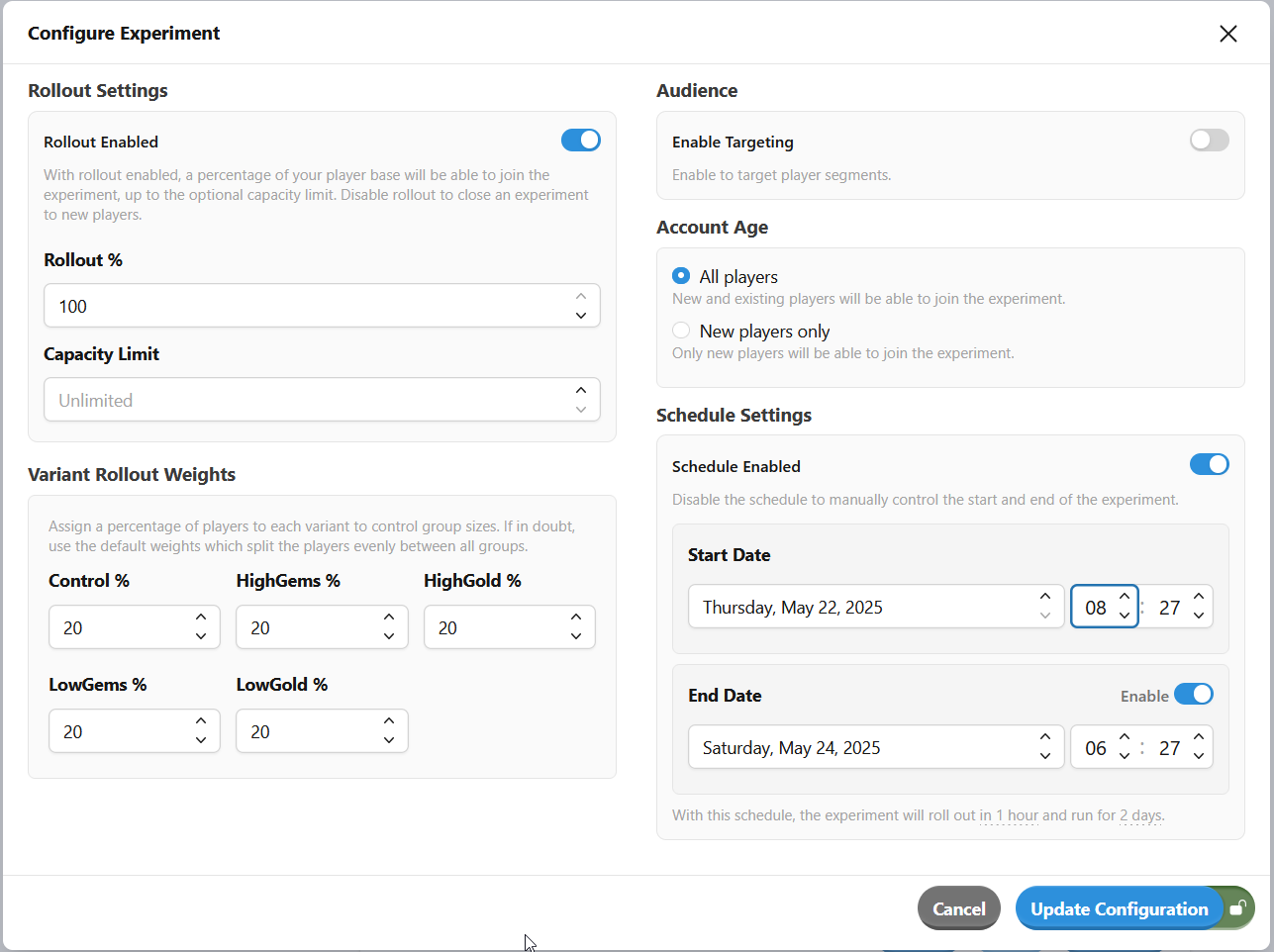Appearance
Introduction to Experiments
Experiments are a tool to conduct controlled studies of how changes to your game configs might affect your players.
Appearance
Experiments are a tool to conduct controlled studies of how changes to your game configs might affect your players.
Experiments allow you to test different game configs on different groups of players. Each Experiment contains one or more Variants, and each Variant contains a set of alternative values to the base game configs.
Players are enrolled in active Experiments if they meet the Audience criteria. They are assigned to either the Control Group or to one of the Variants. This assignment is random, but you can control the relative distribution of players in each group using weights.
Each player model retains a full history of the Experiments that they have participated in. Players generate analytics events when joining an Experiment, and this information is also included in all analytic events that the player generates. You can use this information in your analytics pipeline to later study the efficacy of your Variants.
A player is eligible to be enrolled in an Experiment if they meet the Audience criteria. There are a few different ways to define an Audience for each Experiment, and they can be used together to make a powerful filter for selecting the perfect group of players:

Every Experiment has a lifecycle, and normally, an Experiment will progress forward one phase at a time through this lifecycle. We'll cover this in more detail later on (including reasons why you might want to take a backward step), but for now, it helps to have a general idea of the phases that an Experiment passes through:

The lifecycle as visualized on the LiveOps Dashboard
Take a look at Implementing Experiments for a step-by-step look into how an experiment is implemented.
There are endless different Experiments that you could run on your game. Here are a few suggestions to show you some of the possibilities:
| Name | Hypothesis | Notes | Variants |
|---|---|---|---|
| Early Game Funnel. | If we tweak the early game funnel, then we can discover which settings work best to retain players because players will either prefer a harder or easier early game experience. | A simple experiment with two variants. | [33%] Control: No change. [33%] Harder: Change level one enemies to be 50% weaker. [33%] Easier: Change level one enemies to be 100% stronger. |
| Initial game resource tuning. | If we give new players different initial resource bundles, then we will find an option that increases player retention because some bundles will help players get more invested in the game. | Four variants this time. You also need to set the Account Age of the Experiment's Audience targeting to New Players because this only makes sense to apply to players when they first create an account with you. | [20%] Control: No change. [20%] HighGems: InitialGems * 2. [20%] HighGold: InitialGold * 2. [20%] LowGems: InitialGems * 0.5. [20%] LowGold: InitialGold * 0.5. |
| High price anchoring. | If players see a 100€ purchase in the shop, then they are more likely to purchase items due to the high-priced item making the cheaper items look like better value. | A sneaky psychological hypothesis! But will it work? Running an Experiment is the perfect way to find out. | [50%] Control: No change. [50%] HighPrice: Make a super high-priced IAP item visible. |
| Alternative shop button. | If players see a different icon on the shop button, then they are more likely to purchase items from the shop because they find the different design to be more discoverable and/or engaging. | You don't have to limit yourselves to changing the stats of your game design or economy. You can also put UI configuration into your Game Config, and then you use that in your Experiments. In this case, the name of your shop icon, but you could also store button colors, positions, and more. | [33%] Control: No change. [33%] PiggyBankIcon: Use the pig icon in the tab bar. [33%] ArrowUpIcon: Use the arrow icon in the tab bar. |
| Conversion offer. | If players are presented with a really good value conversion bundle, then they might spend more money later because they are more invested in the game. | You can implement this by changing the contents of an offer in the Experiment. | [33%] Control: No change. [33%] CheapOffers: Show only the low-cost conversion offers. [33%] ExpensiveOffers: Show only the high-cost conversion offer. |
| Alternative theme in Finland. | If players in Finland see a more culturally relevant theme, then they will have increased retention because they are more engaged. | You would define the Audience for this Experiment using a segment that targets players in Finland only. You could then tweak colors, names, icons, or whatever you have available in your Game Config. | [50%] Control: No change. [50%] FinnishTheme: Alternative theme. |
| Alternative happy hour event. | If players see different happy hour events, then we will find out which ones are most popular because players will engage with the ones that they find most interesting. | [20%] Control: No change. [80%] AlternativeContent: Different producer in discount. |
🤝 Here to Help
Hopefully, this document has made you think of some great Experiments of your own, but maybe you're unsure about how to implement them? Take a look at Implementing Experiments. If you have further questions, talk to us - we're here to help!
For more information on implementing your experiments, see Implementing Experiments.
If you're an advanced user of experiments (i.e., you're planning to run multiple experiments at the same time), be sure to check out Optimizing Experiments.